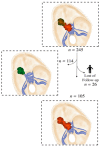Management of Medial Sphenoid Wing Meningioma Involving the Cavernous Sinus: A Single-Center Series of 105 Cases
- PMID: 35565330
- PMCID: PMC9102569
- DOI: 10.3390/cancers14092201
Management of Medial Sphenoid Wing Meningioma Involving the Cavernous Sinus: A Single-Center Series of 105 Cases
Abstract
Objective: Medial sphenoid wing meningiomas are among the three most common intracranial meningiomas. These tumors pose a challenge to neurosurgeons in terms of surgical treatment, as they may involve critical neurovascular structures and invade the cavernous sinus. In case of the latter, a complete resection may not be achievable. The purpose of this study was to investigate prognostic features affecting recurrence and progression-free survival (PFS) of medial sphenoid wing meningiomas involving the cavernous sinus, focusing on the contribution of surgery and postoperative radiotherapy.
Methods: A retrospective analysis was conducted of the database of our institution, and 105 cases of medial sphenoid wing meningioma with invasion of the cavernous sinus, which were treated between 1998 and 2019, were included. Surgical treatment only was performed in 64 cases, and surgical treatment plus postoperative radiotherapy was performed in 41 cases. Kaplan-Meier analysis was conducted to estimate median survival and PFS rates, and Cox regression analysis was applied to determine significant factors that were associated with each therapeutic modality.
Results: The risk of recurrence was significantly reduced after near-total resection (NTR) (p-value = 0.0011) compared to subtotal resection. Progression-free survival was also significantly prolonged after postoperative radiotherapy (p-value = 0.0002).
Conclusions: Maximal safe resection and postoperative stereotactic radiotherapy significantly reduced the recurrence rate of medial sphenoid wing meningiomas with infiltration of the cavernous sinus.
Keywords: cavernous sinus; neurosurgery; postoperative radiotherapy; progression-free survival; sphenoid wing meningioma.
Conflict of interest statement
The authors declare no conflict of interest.
Figures





References
LinkOut - more resources
Full Text Sources

